Ramon’s Report #4
Bioregionalism Education
Summer Session, 2009
July 1 & 3, 2009 – English
(Click here for Spanish/Español)
Photos below
This Wednesday, as always, Franco was the first to arrive to class. Once everyone was there, we played a game called EL BUM. For every multiple of 3, you have to say the word “bum;” for example: 1 2 bum 4 5 bum and so forth. Each time a kid made a mistake, he would have to name a kind of tree or animal from our bioregion.

Afterwards, we made a circle and started to read on the topic of Flora. Luis asked me: “Why is Ecuador considered to be mega diverse?” I told him that it is because we experience what’s considered to be new micro climates, which is something that we’ve witnessed during our field trips. We’ve observed many kinds of trees and plants native to the Dry Tropical Forest, which is inhabited by many species of animals that have adapted to this kind of climate. I also explained that in the hills of San Isidro, where the climate is more humid, the vegetation is very different and the kinds of animals that live there don’t exist in dry forests.
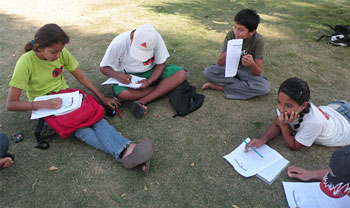
I described the trees that we have in our bioregion, like the Laurel, Ceibo, among many others. I also told them about some of the vegetation, like Muyuyo, Mudroño which serves as food for the deer, and cuchuco which is used as fence posts.
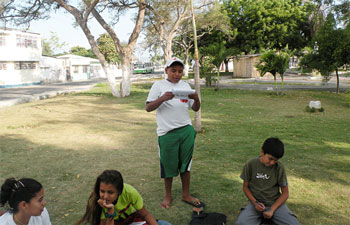
We had a discussion about how, in actuality, our environment faces a lot of threats, primarily, from the human race. The indiscriminate logging of trees, caused by agricultural expansion, has generated soil erosion. A lot of habitats have disappeared, like the mangrove forests in our region. Consequently, there are now people who are seeking to restore and recuperate these places, starting by planting organic products in their farms. With tactics like these, our impact could be lessened and we can find a more balanced form of living within our natural environments.
The kids asked me where we would be going on Friday. I told them that we were going to a reforestation site.
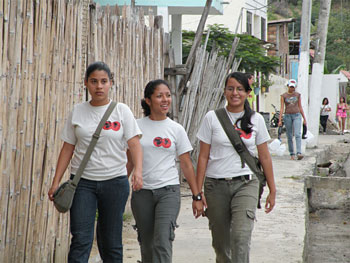
On Friday, I waited at the park for the kids to come. Clay, Raisa and Lissete arrived first. Clay suggested that we take advantage of our visit to take gallons of water along with us to water the trees.
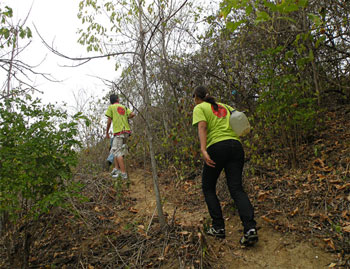
Fabiola arrived with her group of kids and we decided to join our groups for the field trip. Clay made the necessary phone calls to arrange how we could acquire nearby water for the planted site. We went to the Planet Drum house to pick up the empty gallon containers. A lot of the kids were too embarrassed to carry them, especially the girls.

When we arrived to the site, one by one the kids filled up their containers with water and Raisa lead them up the hillside.
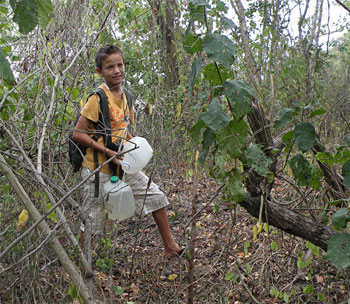
Once we all reached the top, I explained that the hillside had suffered a little bit of damage during the mudslides caused by the El Niño phenomenon. They were able to see and better understand Planet Drum’s reforestation project of planting native trees to prevent the soil from eroding. That is how we will recuperate the flora and fauna of our region, they reasoned.
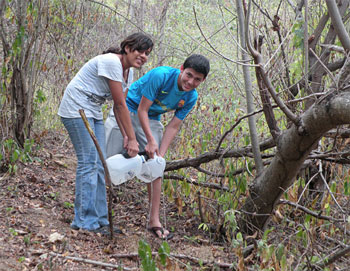
On the way home, none of the kids wanted to carry the empty containers. Ximena, Luis Arturo, Carlos David and Raisa were the only ones to help.
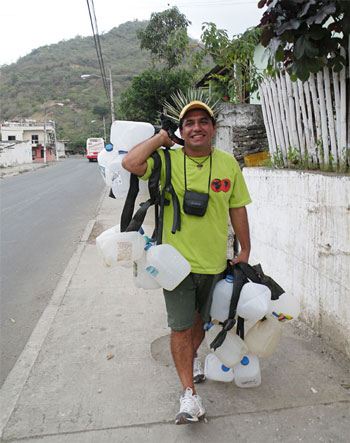
-Ramon
Translated by Paola Divita
Ramon-July 1 & 3, 2009 – Spanish/Español
Este día miércoles fueron llegando todos los chicos, pero como siempre el primero que está en el parque es Franco. Después que todos llegaron, jugamos una dinámica denominada EL BUM, que consiste en que a todo numero múltiplo de 3 se tiene que decir la palabra Bum; por ejemplo: 1 2 bum 4 5 bum. Así sucesivamente, y la persona que se equivoca, tiene que nombrar una especie de vegetal o animal de nuestra bioregión.
Luego de esto hicimos un círculo y todos los chicos empezaron a leer el tema de La Flora. Luis me pregunto “¿Porque Ecuador es mega diverso?” Y yo le respondí que es porque poseemos nuevos micro climas, que hemos podido ver en los recorridos que hemos hecho. Hemos observado muchos árboles y plantas endémicas del bosque seco tropical, que también está habitado por muchas especies de animales que se han adaptado a este tipo de clima. Pero en las lomas más húmedas como las de San Isidro, el tipo de vegetación es diferente y ahí existen animales que no habitan en los bosques secos.
Siguiendo con el tema, les dije que en nuestra bioregión nosotros poseemos en muchos árboles como el laurel y el ceibo, entre otros. También les conversé de los arbustos, como el muyuyo, el mudroño que sirve de alimento para los venados, y el cuchucho que esta utilizado como estacas.
Conversamos que, en actualidad, nuestro ambiente tiene muchas amenazas, algo que es culpa de los seres humanos. La tala indiscriminada de árboles, causada por la expansión agrícola, ha causado la erosión del suelo. Muchos habitas han desaparecido, como los bosques de manglares. Pero ahora hay muchas personas que están tratando de regenerar y recuperar estos lugares, sembrando productos orgánicos en las fincas. Con esto el impacto será menor y podremos manejarnos de una forma equilibrada los seres vivos con la naturaleza.
Después de esto los chicos preguntaron a donde iríamos el viernes. A lo cual les respondí, a un sitio de re vegetación.
El día viernes estaba sentado en el parque esperando que los chicos llegaran. Llegó Clay, Raisa y Lissete. Clay nos dijo que llevemos galones de agua y así aprovechamos de nuestra visita y regamos las plantas de una vez. Yo le respondí que está bien, lo haríamos. Después llegó Fabiola con sus estudiantes y se unió a nuestro grupo de trabajo. Clay comenzó a hacer llamadas muy rápidamente para conseguir agua. Llamó como dos o tres veces hasta que conseguimos el líquido vital para los árboles. Fuimos a la casa de Planet Drum a recoger los galones. Habían muchos chicos que no querían llevar los galones y les daba un poco de vergüenza, jajaja, principalmente las chicas. Mire hacia atrás y vi como venían atrás los chicos con los galones. Llegamos al astillero y Clay fue por la llave. Uno por uno fue llenando los galones con agua, caminando hacia la colina. Raisa se encargó de ir adelante. Cuando yo subí con el último grupo de Fabiola, el grupo de Raisa ya había terminado de regar una parte de los árboles. Les hablé sobre el lugar y expliqué como la colina había sufrido un deslave durante el fenómeno de el niño. Entendieron mejor lo que hace la fundación de Planet Drum; que como parte de su proyecto había reforestado este lugar para que vuelva a tener árboles endémicos y la colina no siga deslizándose. Así vamos a recuperar la flora y fauna. Al terminar todos regresamos a la fundación. Esta vez lo chicos no quisieron llevar los galones, así que solo me ayudaron Ximena, Luis Arturo, Carlos David y Raisa.
-Ramon

Can you be more specific about the content of your article? After reading it, I still have some doubts. Hope you can help me.
Thanks for sharing. I read many of your blog posts, cool, your blog is very good.
Thank you for your sharing. I am worried that I lack creative ideas. It is your article that makes me full of hope. Thank you. But, I have a question, can you help me?
Your point of view caught my eye and was very interesting. Thanks. I have a question for you.